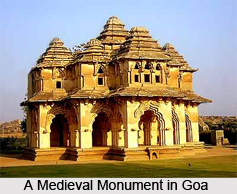 In the early part of the fourteenth century a merchant named Hasan erected a mosque at Sandapur but he was later forced to leave the city. Hasan and his family migrated south to Honavar, also on the coast, and by the time of Ibn Batutah`s visit in 1343 his son Jamal ud-Din, was recognised as Sultan of Honavar. He was apparently a powerful local prince, who was able to field at least 6,000 troops as well as a reasonably sized navy, although he found it politic to pay tribute to the newly created Hindu Empire of Vijayanagar which was subsequently to play such an important role in Goa`s history.
In the early part of the fourteenth century a merchant named Hasan erected a mosque at Sandapur but he was later forced to leave the city. Hasan and his family migrated south to Honavar, also on the coast, and by the time of Ibn Batutah`s visit in 1343 his son Jamal ud-Din, was recognised as Sultan of Honavar. He was apparently a powerful local prince, who was able to field at least 6,000 troops as well as a reasonably sized navy, although he found it politic to pay tribute to the newly created Hindu Empire of Vijayanagar which was subsequently to play such an important role in Goa`s history.
Two events which were to have particular importance for Goa were the creation of the Muslim Bahmani kingdom and that of the Hindu empire of Vijayanagar. Although the Vijayanagar Empire was founded in 1336 it did not immediately come into contact with the Kadamba state. When Goa was captured by Honavar, the ten thousand Hindu inhabitants were simply moved from the central town who had settled in one of the suburbs.
As has already been mentioned even in 1343 the Sultan of Honavar had deemed it politic to pay tribute to the king of Vijayanagar, so that at this stage some sort of over lordship was acknowledged, but by 1358 certainly a major part of the Konkan acknowledged the rule of the Bahmanis. Madhava Raya was also a great Vedic scholar and he was concerned to re-establish the Hindu traditions which had been interrupted by the Bahmani interregnum. One of his major acts was the reconstruction of the shrine of Saptakoteshwara and the re-installation of the lingam which had been hidden during the Bahmani period.
The significance of the Mandovi at this time under the Vijayanagar Empire is borne out by the village of Ribandar which is a small town on a hill overlooking a natural harbour on the river. The name in fact means the harbour of the rayas, or kings, and refers to the kings of Vijayanagar.
During this entire period wars continued between the Vijayanagar and Bahmani kingdoms with both sides being fairly evenly balanced. In this naturally Goa acted as one of the main ports for the Vijayanagar Empire, particularly for the importation of horses from the Gulf. Events continued` in this way until in 1469 the then king of Vijayanagar, Virupaksha Raya II, moved against the Muslims of the Konkan in a singularly thoughtless fashion. Some of these horses were also being sold to the Bahmanis, and in 1469 Virupaksha getting angry at this, ordered his vassal in Honavar to kill as many Muslims as possible and drive the rest away, hi the subsequent slaughter some ten thousand are said to have lost their lives. The remaining survivors fled and settled in Goa. This provided the excuse for which the Bahmanis were looking, and they accordingly attacked to save their co-religionists.
In 1425 Ahmad Shah Bahmani had moved his capital from Gulbarga to Bidar, and it was to this court in 1453 that the most remarkable figure of the age first appeared. Mahmud Gawan was originally a merchant from Persia who had first appeared in Dhabol and then made his way to Bidar where he entered the service of the Bahmanis and where his exceptional talents soon made themselves felt. His rise was rapid and by 1461 was a member of a three-man Council of Regency for the young king, and by 1466 was Chief Minister with the title Vakil us-Sultanat (Deputy of the Kingdom). He was to remain in supreme authority until his death in 1481. During this time he brought the whole of the Bombay-Karnatak under Bahmani sway, and also subjugated the Konkan and captured the port of Goa which Gawan himself described as the `envy of the islands and ports of India
By 1490, in fact if not in name, the Bahmani Kingdom had ceased to exist and had been replaced by five Sultanates, the Qutb Shahi of Golconda, the Nizam Shahi of Ahmednagar, the Barid Shahi of Bidar, the `I mad Shahi of Berar, and the `Adil Shahi of Bijapur. Goa and the territory of the Konkan came within the power of Yusuf `Adil Shah, ruler of Bijapur and in fact Goa was considered the second city of his kingdom and the brightest jewel in his crown.



















